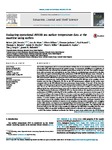Evaluating operational AVHRR sea surface temperature data at the coastline using surfers
| dc.contributor.author | Brewin, RJW | |
| dc.contributor.author | de Mora, L | |
| dc.contributor.author | Billson, O | |
| dc.contributor.author | Jackson, Thomas | |
| dc.contributor.author | Russell, Paul | |
| dc.contributor.author | Brewin, TG | |
| dc.contributor.author | Shutler, JD | |
| dc.contributor.author | Miller, PI | |
| dc.contributor.author | Taylor, BH | |
| dc.contributor.author | Smyth, TJ | |
| dc.contributor.author | Fishwick, JR | |
| dc.date.accessioned | 2018-02-22T10:38:20Z | |
| dc.date.available | 2018-02-22T10:38:20Z | |
| dc.date.issued | 2017-09 | |
| dc.identifier.issn | 0272-7714 | |
| dc.identifier.uri | http://hdl.handle.net/10026.1/10839 | |
| dc.description.abstract |
Sea surface temperature (SST) is an essential climate variable that can be measured routinely from Earth Observation (EO) with high temporal and spatial coverage. To evaluate its suitability for an application, it is critical to know the accuracy and precision (performance) of the EO SST data. This requires comparisons with co-located and concomitant in situ data. Owing to a relatively large network of in situ platforms there is a good understanding of the performance of EO SST data in the open ocean. However, at the coastline this performance is not well known, impeded by a lack of in situ data. Here, we used in situ SST measurements collected by a group of surfers over a three year period in the coastal waters of the UK and Ireland, to improve our understanding of the performance of EO SST data at the coastline. At two beaches near the city of Plymouth, UK, the in situ SST measurements collected by the surfers were compared with in situ SST collected from two autonomous buoys located ∼7 km and ∼33 km from the coastline, and showed good agreement, with discrepancies consistent with the spatial separation of the sites. The in situ SST measurements collected by the surfers around the coastline, and those collected offshore by the two autonomous buoys, were used to evaluate the performance of operational Advanced Very High Resolution Radiometer (AVHRR) EO SST data. Results indicate: (i) a significant reduction in the performance of AVHRR at retrieving SST at the coastline, with root mean square errors in the range of 1.0 to 2.0 °C depending on the temporal difference between match-ups, significantly higher than those at the two offshore stations (0.4 to 0.6 °C); (ii) a systematic negative bias in the AVHRR retrievals of approximately 1 °C at the coastline, not observed at the two offshore stations; and (iii) an increase in the root mean square error at the coastline when the temporal difference between match-ups exceeded three hours. Harnessing new solutions to improve in situ sampling coverage at the coastline, such as tagging surfers with sensors, can improve our understanding of the performance of EO SST data in coastal regions, helping inform users interested in EO SST products for coastal applications. Yet, validating EO SST products using in situ SST data at the coastline is challenged by difficulties reconciling the two measurements, which are provided at different spatial scales in a dynamic and complex environment. | |
| dc.format.extent | 276-289 | |
| dc.language | en | |
| dc.language.iso | en | |
| dc.publisher | Elsevier BV | |
| dc.title | Evaluating operational AVHRR sea surface temperature data at the coastline using surfers | |
| dc.type | journal-article | |
| dc.type | Journal Article | |
| plymouth.volume | 196 | |
| plymouth.publication-status | Published | |
| plymouth.journal | Estuarine, Coastal and Shelf Science | |
| dc.identifier.doi | 10.1016/j.ecss.2017.07.011 | |
| plymouth.organisational-group | /Plymouth | |
| plymouth.organisational-group | /Plymouth/Admin Group - REF | |
| plymouth.organisational-group | /Plymouth/Admin Group - REF/REF Admin Group - FoSE | |
| plymouth.organisational-group | /Plymouth/Faculty of Science and Engineering | |
| plymouth.organisational-group | /Plymouth/Faculty of Science and Engineering/School of Biological and Marine Sciences | |
| plymouth.organisational-group | /Plymouth/REF 2021 Researchers by UoA | |
| plymouth.organisational-group | /Plymouth/REF 2021 Researchers by UoA/UoA07 Earth Systems and Environmental Sciences | |
| plymouth.organisational-group | /Plymouth/Research Groups | |
| plymouth.organisational-group | /Plymouth/Research Groups/Marine Institute | |
| plymouth.organisational-group | /Plymouth/Users by role | |
| plymouth.organisational-group | /Plymouth/Users by role/Academics | |
| dc.rights.embargoperiod | Not known | |
| rioxxterms.versionofrecord | 10.1016/j.ecss.2017.07.011 | |
| rioxxterms.licenseref.uri | http://www.rioxx.net/licenses/all-rights-reserved | |
| rioxxterms.type | Journal Article/Review | |
| plymouth.funder | NCEO Radiation and Climate::NERC |


